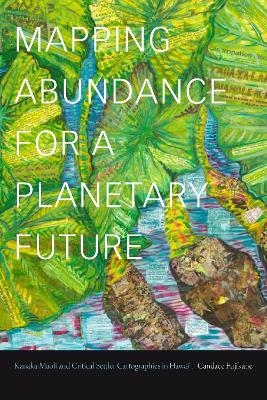
Mapping Abundance for a Planetary Future
Duke University Press (Verlag)
978-1-4780-1056-2 (ISBN)
In Mapping Abundance for a Planetary Future, Candace Fujikane contends that the practice of mapping abundance is a radical act in the face of settler capital's fear of an abundance that feeds. Cartographies of capital enable the seizure of abundant lands by enclosing "wastelands" claimed to be underdeveloped. By contrast, Kanaka Maoli (Native Hawaiian) cartographies map the continuities of abundant worlds. Vital to restoration movements is the art of kilo, intergenerational observation of elemental forms encoded in storied histories, chants, and songs. As a participant in these movements, Fujikane maps the ecological lessons of these elemental forms: reptilian deities who protect the waterways, sharks who swim into the mountains, the navigator Māui who fishes up the islands, the deities of snow and mists on Mauna Kea. The laws of these elements are now being violated by toxic waste dumping, leaking military jet fuel tanks, and astronomical-industrial complexes. As Kānaka Maoli and their allies stand as land and water protectors, Fujikane calls for a profound attunement to the elemental forms in order to transform climate events into renewed possibilities for planetary abundance.
Candace Fujikane is Professor of English at the University of Hawai‘i and coeditor of Asian Settler Colonialism: From Local Governance to the Habits of Everyday Life in Hawai‘i.
Note on the Text xi
Acknowledgments xiii
Introduction. Abundant Cartographies for a Planetary Future 1
1. Moʻoʻāina as Cartographic Method: Recovering the Birthplace of Māui in Waiʻanae 31
2. Maps in Motion: Mapping Wonder in Waiʻana on Huakaʻi Aloha ʻĀina 60
3. Moʻoinanea's Waterways on Mauna a Wākea: Beyond Settler Colonial Thresholds in the Wao Aku 86
4. Kūpuna Pōhaku on Mauna a Wākae: Spiraling Back to the Piko 115 5. Vertical Maps of Subterranean Waters in Kalihi: The Laws of Haumea and Kānemilohae 144 6. Moʻoʻāina Cascades in Waiāhole and Heʻeia: A Cartography of Haumea and Kānemilohae 144
Conclusion. ʻIwakilomoku: Foreseeing a Future beyond Capital 208
Notes 221
Bibliography 243
Index 257
| Erscheinungsdatum | 19.01.2021 |
|---|---|
| Zusatzinfo | 53 illustrations, incl. 16 in color |
| Verlagsort | North Carolina |
| Sprache | englisch |
| Maße | 152 x 229 mm |
| Gewicht | 590 g |
| Themenwelt | Sachbuch/Ratgeber ► Geschichte / Politik ► Allgemeines / Lexika |
| Sachbuch/Ratgeber ► Geschichte / Politik ► Regional- / Landesgeschichte | |
| Geisteswissenschaften ► Geschichte ► Regional- / Ländergeschichte | |
| Geschichte ► Teilgebiete der Geschichte ► Kulturgeschichte | |
| ISBN-10 | 1-4780-1056-8 / 1478010568 |
| ISBN-13 | 978-1-4780-1056-2 / 9781478010562 |
| Zustand | Neuware |
| Informationen gemäß Produktsicherheitsverordnung (GPSR) | |
| Haben Sie eine Frage zum Produkt? |
aus dem Bereich


